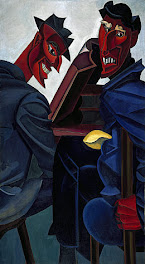Studying Art History, my wife spent a good deal of time looking at various things such as statues of the Buddha in various cultures. As part of these studies the abilities of the natural sciences were utilized, as well as the methodologies of history and art history in particular.
Natural science, for its part, can tell you many interesting things about a statue of a Buddha. It can give you its measurements to uncanny detail, its composition, approximate age, the probable locale from which the stone was quarried and the distance to where the statue was located, the exact physical latitude and longitude of that location, etc. I could go on and on.
And yet for all the natural sciences can add to the repertoire of knowledge an Art Historian has regarding a particular statue of the Buddha located in a particular place in the far east, it all remains a more or less irrelevant addendum. To those not familiar with the different sciences, their different realms of study, methodologies and applicability this may seem either simply odd, or part of some “unscientific” plot to keep the natural sciences out of art history.
So what is it that the natural sciences cannot tell us about the particular object of study that we have in front of us, a statue of the Buddha from any given ancient eastern culture?
Firstly, as an object, there is nothing theoretically or practically of importance that the natural sciences cannot tell us. True, on a quantum level there are things that are indeterminate even theoretically, but they don't really impact the type of knowledge that art history is. But we didn't begin by discussing an 'object'. We began by discussing a statue, in this case of the Buddha.
No matter how accurate the natural sciences can describe the objects form and material composition, nothing in its properties can determine for science that the object is, in fact, a statue. 'Statue' is not a determination of an object at all, it is a determination of a thing. 'Things' always exist in and for a World of comprehension and form part of that world of context and meaning. The 'historical' part of art history deals with this statue precisely in its context and meaning as a thing, and with a rigor unknown to the simple exactness of natural science attempts to reconstruct some of that World of meaning that gave birth to the thing.
We aren't finished with the statue by examining its thingliness in the context of its world (or ours), though. It is not simply a statue, but a statue of the Buddha. History exhausts itself in its determinations of the statue as situated, contextualized thing, but we are looking at it through the methodologies of art history, not simple history. As art the statue is a Work, a work that reveals the Buddha by presenting the Buddha.
As a result of a myth that crept into simplistic art history at some point, and has been difficulty to stamp out, there is an idea that art somehow 'progresses'. Concomitant with that myth is the myth that art is by and large 'representational' in nature. It results, in the worst cases, in the notion that pictorial art was some type of primitive method of photography that 'progressed' to higher and higher realism but has now been replaced by 'real' photography and continues as some sort of 'cultural' curiosity.
In contrast to this, the statue of the Buddha does not represent, because nothing was presented formerly that could then be re-presented. It is also not symbolic, it does not function as a symbol of something that somehow exists similarly but differently elsewhere as in the semiotic signifier/signified pairing. It makes as little sense to say that the statue is not the Buddha as it does to say that the statue is the Buddha. The statue reveals the Buddha. It also makes no sense to say, well, perhaps it does for Buddhists, but not for rational westerners. Belief is not at issue in the statue, because it was not at issue in the World that the statue hails from. Belief implies the choice between belief and doubt. One can, I suppose, doubt that trees exist, but it doesn't make one a more rational westerner, it makes one of interest to psychiatrists. The same goes for the statue of the Buddha within its context.
Why did natural science have no means of looking at the meaning either of the thing as a statue, or the work as the Buddha? Natural science doesn't deal with things, or works, fundamentally it deals with objects, which is to say it doesn't deal with meaning, understanding, or truth, but with description, explanation, and correctness.
Subscribe to:
Post Comments (Atom)
+-+1920-21+A+Reading+of+Ovid+(Tyros).jpeg)



No comments:
Post a Comment